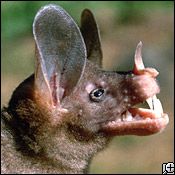The largest bat in the New World and the only species in its genus, Vampyrum spectrum was once thought to drink blood. It is now known to feed instead on rodents, birds, and occasionally insects, as well as other bats — hence the word "false" in its common name.
The bats capture mice by pouncing on them and breaking their neck, back, or skull. They grasp birds by the beak and crush the skull with their teeth. Food is usually taken to a roost to be eaten.
Advertisement
Unlike most bats, they are believed to pair-bond. The male has been observed folding its wings around the female and young while nesting by day, presumably to aid in heat retention.
They roost in small groups, usually in hollow trees or snags.
Habitat destruction seriously threatens the species.
Advertisement
